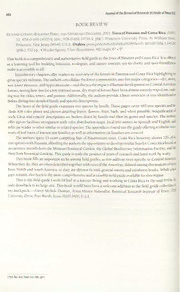
BOOK REVIEW PDF
Preview BOOK REVIEW
1 : Journal of the Botanical Research Institute of Texas 5(2) BOOK REVIEW Panama and Costa Trees of Rica. Rolando and Nefertaris Daguerre. 201 (ISBN- Richard Condit, PErez, 1 William Princeton University Press, 41 978-0-691-14707-9, hbk.; 978-0-691-14710-9, pbk.). Street, 13: $85.00 New (Orders: press.princeton.edu/titles/9289.html). (hbk.), $45.00 08540, U.S.A. Princeton, Jersey H 482 maps, 6" x 9 438 5 552 color figures, line illustrations, (pbk.), pp., . This book a comprehensive and authoritative field guide to the trees of Panama and Costa Rica. It is offered is and budding and nature tourists, yet its clarity user-friendliness as a learning tool for botanists, ecologists, make accessible to it all. Panama and Costa Rica highlighting Introductory chapters offer readers an overview of the forests in its — great species richness. The authors consolidate the forest communities into five major categories dry, moist, — human on development Central American lower montane, and upper montane and discuss the impact of wet, wiped forests, noting how, but for a few remnant areas, dry tropical forests have been almost entirely out, mak- ing way for cities, towns, and pasture. Additionally, the authors provide a basic overview of tree identification and before diving into detailed family species descriptions. 493 and The heart of the guide examines tree species by family. These pages cover tree species in- field when clude 438 color plates and photos detailing leaves, flowers, fruit, bark, and possible, magnification of such. Clear and concise descriptions are broken down by family and then by genus and species. The authors offer tips to facilitate recognition with color distribution maps, local tree names in Spanish and English, and refer the reader to other similar or related species. The appendices round out the guide offering a tabular sum- mary known on of leaf traits of tree families as well as information families not covered. 72% The authors spent 15 years compiling lists of Panamanian trees. Costa Rica however, shares of its tree species with Panama, affording the authors the opportunity to develop similar lists for Costa Rica based on occurrence records from the Missouri Botanical Garden, the Global Biodiversity Information Facility, and the | New York Botanical Gardens. This guide truly the product of years of research and hard work by many. is This book fills an important niche among field guides, as few address trees specific to Central America. When they they among do, are often described together with trees of the Americas, diluted discussions of trees from North and South America, or they are thrown in with general nature and rainforest books. While a few gaps remain, this book the most comprehensive and is accessible field guide available for this region. This is the field guide I wish I’d had as a forester living and working in Costa Rica in the mid-1990s. Its j only drawback is its large size. This book would have been a welcome addition to the field guide collection in — my Gwen backpack. Michele Thomas, Texas Master 1700 Naturalist, Botanical Research Texas, Institute of University Drive, Fort Worth, Texas 76107-3400, U.S.A.
